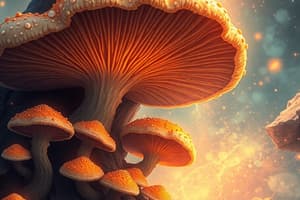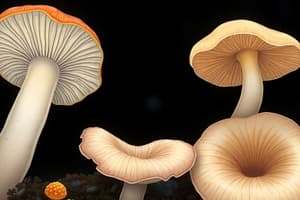Podcast
Questions and Answers
What are blastospores?
What are blastospores?
- Small buds developed from which independent cells grow (correct)
- Spores with small spine-like projections in their wall
- A type of asexual reproductive spore produced at the tip or side of hyphae
- Thick-walled, single-celled spores produced by aerial hyphae
Where do chlamydospores occur?
Where do chlamydospores occur?
- At the tip or side of hyphae
- On special spore-producing structures called conidiophores
- As independent cells after getting matured
- In the middle, side, or end of the hyphae (correct)
What happens to conidiospores when they mature?
What happens to conidiospores when they mature?
- They develop small spine-like projections in their wall
- The spores detach and become independent (correct)
- They become independent after getting matured
- They detach and become resistant to adverse environments
What is the primary characteristic that distinguishes conidia and sporangiospores?
What is the primary characteristic that distinguishes conidia and sporangiospores?
How are asexual spores like chlamydospores and microconidia produced in F. oxysporum?
How are asexual spores like chlamydospores and microconidia produced in F. oxysporum?
What is the distinguishing feature of arthrospores in terms of their development?
What is the distinguishing feature of arthrospores in terms of their development?
In which type of fungi do blastospores occur?
In which type of fungi do blastospores occur?
Chlamydospores are produced by aerial hyphae and are highly resistant to adverse environments.
Chlamydospores are produced by aerial hyphae and are highly resistant to adverse environments.
Blastospores become independent after getting matured.
Blastospores become independent after getting matured.
Conidiospores are always produced at the tip of the hyphae or on special spore-producing structures called conidiophores.
Conidiospores are always produced at the tip of the hyphae or on special spore-producing structures called conidiophores.
Asexual spores (mitospores) are produced through meiosis.
Asexual spores (mitospores) are produced through meiosis.
Chlamydospores, microconidia, and macroconidia are all produced by F. oxysporum.
Chlamydospores, microconidia, and macroconidia are all produced by F. oxysporum.
Sporangiospores are observed in Ascomycetes fungi.
Sporangiospores are observed in Ascomycetes fungi.
Arthrospores leave the hyphae and become independent through fragmentation.
Arthrospores leave the hyphae and become independent through fragmentation.
Flashcards are hidden until you start studying




